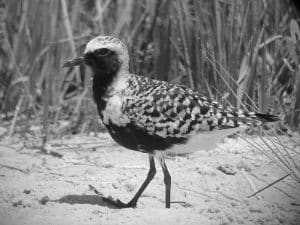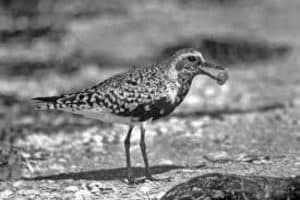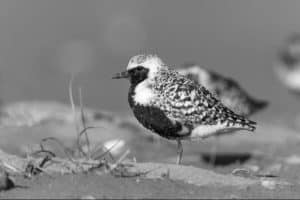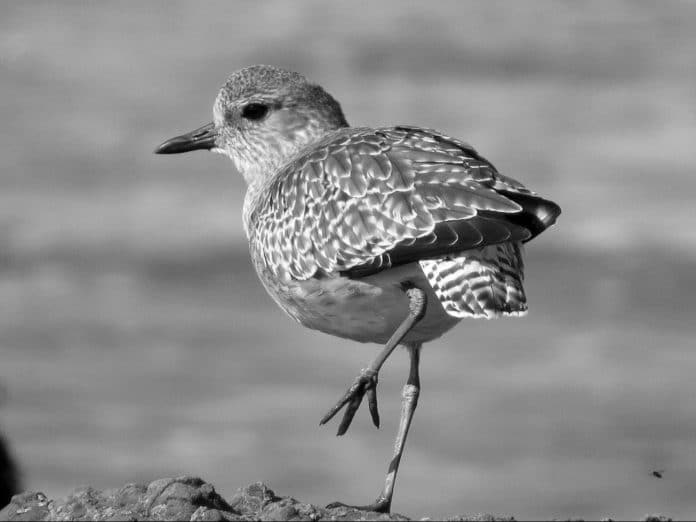Introduction to the black-bellied plover in Tanzania
The black-bellied plover in Tanzania, scientifically known as Pluvialis squatarola, is a fascinating bird species that can be found along the coast of Tanzania, a country located in Eastern Africa. These coastal residents are known for their unique physical characteristics and behavior, making them a popular subject for birdwatchers and wildlife enthusiasts. In this article, we will explore the habitat, distribution, migration patterns, breeding habits, conservation status, and the importance of black-bellied plovers in the coastal ecosystems of Eastern Africa. So, let’s dive into the world of these magnificent birds and discover the wonders they bring to Tanzania’s coastal regions.
Habitat and distribution of the black-bellied plover in Tanzania

Black-bellied plovers are primarily found along the coasts of Tanzania, where they inhabit a variety of coastal habitats such as sandy beaches, mudflats, salt marshes, and estuaries. These birds have a wide distribution range, extending from the northern coast of Tanzania to the southern regions, including the islands of Zanzibar and Pemba. They can also be spotted in other countries along the eastern coast of Africa, including Kenya and Mozambique.
During the non-breeding season, black-bellied plovers can be found in large flocks, often mingling with other shorebird species. They are known to form mixed-species foraging groups, taking advantage of the abundant food resources found in the intertidal zones. However, during the breeding season, which occurs in the northern hemisphere, these birds migrate to the Arctic tundra in North America and Eurasia.
Physical characteristics and behavior of the black-bellied plover
The black-bellied plover is a medium-sized shorebird with a distinctive appearance. During the breeding season, males display a striking black underbelly, contrasting with their white neck, face, and forehead. The back and wings are a mottled brown color, providing excellent camouflage in their natural habitat. Females, on the other hand, have a less contrasting plumage, with a lighter underbelly and more subdued markings.
One of the most fascinating aspects of the black-bellied plover’s behavior is its feeding strategy. These birds have a unique feeding technique called “run-stop-peck,” where they run swiftly along the shoreline, stop abruptly to peck at prey items, and then continue their run. This behavior allows them to efficiently capture small invertebrates, including insects, crustaceans, and mollusks, which are essential for their survival.
Apart from their feeding behavior, black-bellied plovers are known for their distinct vocalizations. During the breeding season, males produce a melodious whistle-like call, often heard during their aerial displays to attract females. These vocalizations can be a treat for birdwatchers, as they add to the overall experience of observing these magnificent birds in their natural habitat.
Migration patterns and breeding habits of the black-bellied plover
The black-bellied plover is a migratory bird, undertaking long-distance journeys between its breeding and non-breeding grounds. In Tanzania, these birds can be observed during the non-breeding season, as they make their way from the Arctic tundra to the coastal regions of Eastern Africa. The migration routes of black-bellied plovers are awe-inspiring, with some individuals traveling over 10,000 kilometers to reach their destination.
During the breeding season, black-bellied plovers form monogamous pairs, with males engaging in elaborate courtship displays to attract females. These displays involve aerial acrobatics, such as soaring high in the sky while producing their distinctive whistle-like calls. Once a pair is formed, they select a suitable nesting site on the Arctic tundra, where the female lays a clutch of four eggs. Both parents take turns incubating the eggs, which hatch after approximately 26 days.
After the chicks hatch, they are precocial, meaning they are capable of walking and foraging shortly after birth. The parents diligently care for their young, protecting them from predators and guiding them in their search for food. Once the chicks have gained enough strength and developed their flight feathers, they embark on their first migration journey, following the same route their parents took.
Conservation status and threats to the black-bellied plover in Tanzania

The black-bellied plover is currently classified as a species of “Least Concern” by the International Union for Conservation of Nature (IUCN). However, like many other migratory shorebirds, these birds face various threats throughout their range, including Tanzania. Habitat loss and degradation due to coastal development, pollution, and climate change are the primary concerns for their long-term survival.
Coastal development projects, such as the construction of hotels and resorts, can lead to the destruction of important feeding and nesting sites for black-bellied plovers. The conversion of natural habitats into human-dominated landscapes disrupts their breeding and foraging patterns, ultimately affecting their population numbers. Pollution from industrial and agricultural activities can contaminate the coastal waters, reducing the availability of prey species and posing health risks to these birds.
Climate change is another significant threat to the black-bellied plover and other migratory species. Rising sea levels, increased storm activity, and altered weather patterns can disrupt their migration routes and breeding cycles. Changes in temperature and precipitation can also affect the availability of food resources, leading to decreased reproductive success and overall population decline.
Efforts are being made to address these threats and conserve the black-bellied plover in Tanzania. National parks and protected areas play a crucial role in safeguarding their habitats, providing safe havens for these birds to breed and rest during their migration. Conservation organizations and researchers are also working towards raising awareness about the importance of these birds and advocating for their protection through education and community involvement.
Importance of the black-bellied plover in the coastal ecosystems of Eastern Africa
Black-bellied plovers play a vital role in the coastal ecosystems of Eastern Africa, contributing to the overall health and balance of these environments. As they forage along the shoreline, these birds help control populations of small invertebrates, including insects and mollusks. By feeding on these organisms, they prevent them from becoming overly abundant, which can have negative impacts on the coastal ecosystem.
Additionally, black-bellied plovers serve as indicators of the overall health of coastal habitats. Their presence or absence in certain areas can provide valuable information about the condition of the ecosystem and the availability of food resources. Monitoring the population trends and distribution of these birds can help scientists assess the impact of human activities and climate change on coastal ecosystems.
Furthermore, black-bellied plovers contribute to the aesthetic value of Tanzania’s coastal regions. Their graceful flight, striking plumage, and unique behaviors make them a delight to observe and photograph. Many birdwatchers and wildlife enthusiasts visit Tanzania specifically to catch a glimpse of these beautiful birds, thereby contributing to the local economy through ecotourism.
Research and monitoring efforts for the black-bellied plover in Tanzania
Researchers and conservation organizations are actively involved in studying and monitoring black-bellied plovers in Tanzania. These efforts aim to gather valuable data on their population size, distribution, migration patterns, breeding success, and overall health. By studying these aspects, scientists can gain insights into the factors affecting these birds and implement targeted conservation strategies.
One of the key research methods used for monitoring black-bellied plovers is bird banding. Individual birds are captured, fitted with unique identification bands, and released back into the wild. If a banded bird is recaptured or spotted by another researcher or birdwatcher, it provides valuable information about their movements, survival rates, and migration routes.
In addition to bird banding, researchers also conduct surveys and censuses in known black-bellied plover habitats. These surveys involve counting the number of individuals present, documenting their behavior, and recording any changes in their population size. Long-term monitoring efforts help track population trends and identify conservation priorities for these birds.
Best places to spot and observe the black-bellied plover in Tanzania
If you’re interested in spotting and observing black-bellied plovers in Tanzania, there are several fantastic locations along the coast where you can increase your chances of encountering these remarkable birds. Here are some of the best places to visit:
- Saadani National Park: Located along the northern coast of Tanzania, Saadani National Park offers a unique opportunity to witness the diversity of wildlife, including black-bellied plovers. The park’s proximity to the coast provides an ideal habitat for these birds, making it a must-visit destination for birdwatchers.
- Pangani Bay: Situated in the Tanga region, Pangani Bay is a picturesque location known for its stunning coastal scenery and rich birdlife. Here, you can spot black-bellied plovers foraging along the sandy beaches and mudflats, especially during the non-breeding season.
- Mafia Island Marine Park: Located off the coast of mainland Tanzania, Mafia Island is a paradise for birdwatchers and nature enthusiasts. The island’s protected marine park offers a diverse range of habitats, including mangroves, coral reefs, and sandy beaches, attracting a wide variety of bird species, including black-bellied plovers.
Remember to respect the birds’ natural habitat and observe them from a distance to avoid causing any disturbance. Binoculars and telephoto lenses are essential tools for birdwatching, allowing you to enjoy these birds up close without intruding on their space.
Tips for birdwatching and photography of the black-bellied plover

Birdwatching and photography can be rewarding experiences when observing black-bellied plovers. Here are some tips to enhance your birdwatching and photography skills:
- Patience is key: Black-bellied plovers can be skittish and easily disturbed. Take your time and observe their behavior from a distance. Avoid sudden movements or loud noises that may startle them. By remaining patient and calm, you increase your chances of witnessing their natural behaviors.
- Study their habitat: Familiarize yourself with the preferred habitats of black-bellied plovers. Sandy beaches, mudflats, and estuaries are prime locations to spot these birds. Look for areas with tidal movements, as they attract a variety of prey species.
- Learn their vocalizations: Black-bellied plovers have distinct vocalizations that can help you locate them. Familiarize yourself with their calls before heading out for birdwatching. By recognizing their vocalizations, you can narrow down their location and increase your chances of spotting them.
- Use appropriate equipment: Invest in a good pair of binoculars or a spotting scope to observe black-bellied plovers from a distance. For photography, consider using a telephoto lens to capture detailed images without disturbing the birds. Tripods or monopods can also help stabilize your camera and achieve sharper images.
- Respect their space: Remember that these birds are wild animals and need their space to thrive. Avoid getting too close or disturbing their feeding or nesting areas. Respect their natural behaviors and allow them to go about their daily activities undisturbed.
By following these tips, you can enhance your birdwatching and photography experiences while ensuring the well-being of black-bellied plovers and other wildlife.
Conclusion
The black-bellied plover, a coastal resident of Tanzania, captivates birdwatchers and nature enthusiasts alike with its unique physical characteristics, behavior, and important role in the coastal ecosystems of Eastern Africa. These birds have adapted to thrive in a variety of coastal habitats, making Tanzania an ideal destination for observing and studying them. However, they face various threats, including habitat loss, pollution, and climate change, which require conservation efforts to ensure their long-term survival.
By understanding the importance of black-bellied plovers, supporting research and monitoring efforts, and practicing responsible birdwatching and photography, we can contribute to the conservation of these magnificent birds. So, grab your binoculars, head to the stunning coastlines of Tanzania, and immerse yourself in the beauty of the black-bellied plover and the coastal ecosystems they call home.


































